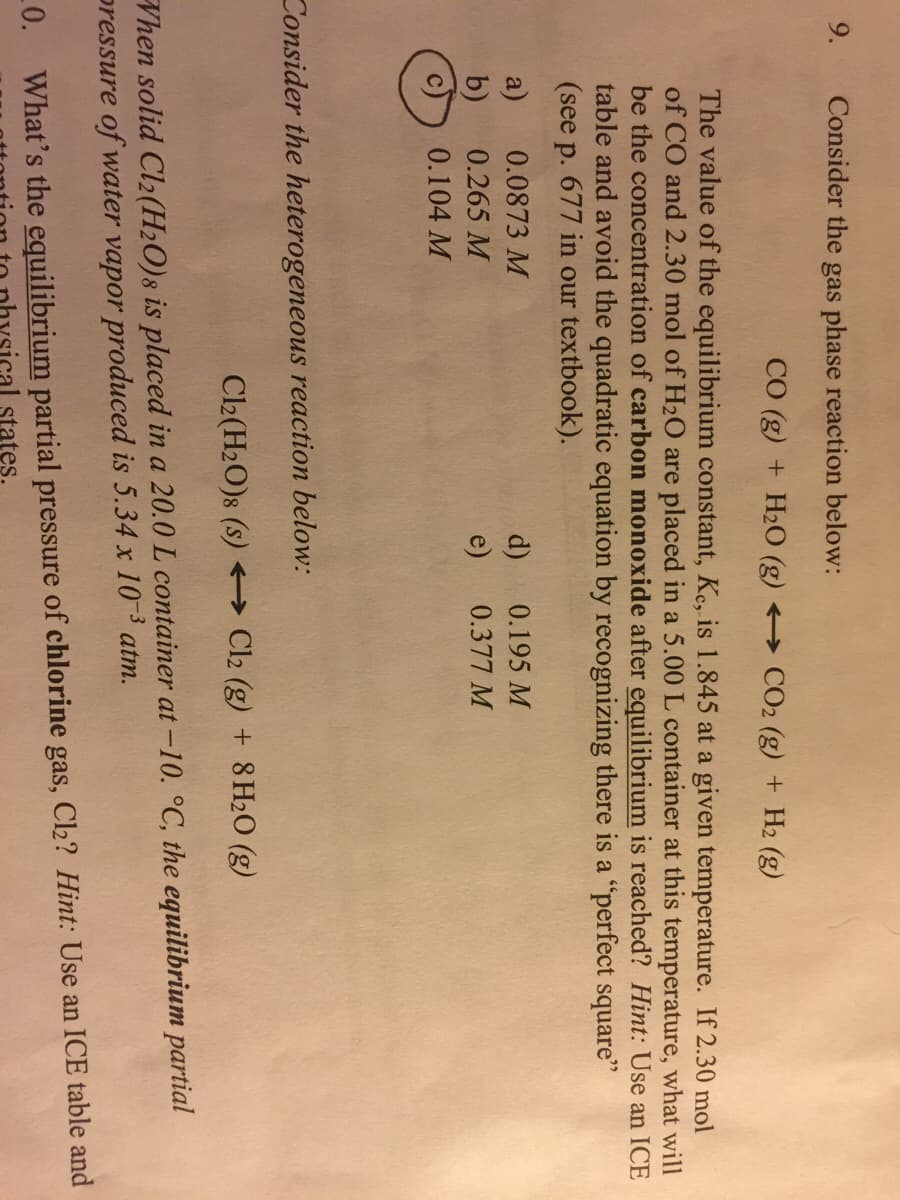Consider the gas phase reaction below: CO (g) + H2O (g) → CO2 (g) + H2 (g) The value of the equilibrium constant, Ke, is 1.845 at a given temperature. If 2.30 mol of CO and 2.30 mol of H2O are placed in a 5.00 L container at this temperature, what will be the concentration of carbon monoxide after equilibrium is reached? Hint: Use an ICE table and avoid the quadratic equation by recognizing there is a "perfect square" (see p. 677 in our textbook). a) b) 0.104 M 0.0873 M d) 0.195 M 0.265 M e) 0.377 M
Consider the gas phase reaction below: CO (g) + H2O (g) → CO2 (g) + H2 (g) The value of the equilibrium constant, Ke, is 1.845 at a given temperature. If 2.30 mol of CO and 2.30 mol of H2O are placed in a 5.00 L container at this temperature, what will be the concentration of carbon monoxide after equilibrium is reached? Hint: Use an ICE table and avoid the quadratic equation by recognizing there is a "perfect square" (see p. 677 in our textbook). a) b) 0.104 M 0.0873 M d) 0.195 M 0.265 M e) 0.377 M
Introductory Chemistry: A Foundation
9th Edition
ISBN:9781337399425
Author:Steven S. Zumdahl, Donald J. DeCoste
Publisher:Steven S. Zumdahl, Donald J. DeCoste
Chapter17: Equilibrium
Section: Chapter Questions
Problem 51QAP: . For the reaction 3O2(g)2O3(g)The equilibrium constant, K, has the value 1.121054at a particular...
Related questions
Question

Transcribed Image Text:9.
Consider the gas phase reaction below:
CO (g) + H2O (g) → CO2 (g) + H2 (g)
The value of the equilibrium constant, Ke,
of CO and 2.30 mol of H20 are placed in a 5.00 L container at this temperature, what will
be the concentration of carbon monoxide after equilibrium is reached? Hint: Use an ICE
table and avoid the quadratic equation by recognizing there is a "perfect square"
(see p. 677 in our textbook).
1.845 at a given temperature. If 2.30 mol
0.0873 M
a)
b)
0.195 M
d)
e)
0.265 M
0.377 M
0.104 M
Consider the heterogeneous reaction below:
Cl2(H2O)8 (s) → Cl2 (g) + 8H2O (g)
When solid Cl2(H2O)8 is placed in a 20.0 L container at -10. °C, the equilibrium partial
pressure of water vapor produced is 5.34 x 103 atm.
0. What's the equilibrium partial pressure of chlorine gas, Cl2? Hint: Use an ICE table and
al states.
Expert Solution
This question has been solved!
Explore an expertly crafted, step-by-step solution for a thorough understanding of key concepts.
This is a popular solution!
Trending now
This is a popular solution!
Step by step
Solved in 3 steps with 3 images

Knowledge Booster
Learn more about
Need a deep-dive on the concept behind this application? Look no further. Learn more about this topic, chemistry and related others by exploring similar questions and additional content below.Recommended textbooks for you

Introductory Chemistry: A Foundation
Chemistry
ISBN:
9781337399425
Author:
Steven S. Zumdahl, Donald J. DeCoste
Publisher:
Cengage Learning

Chemistry by OpenStax (2015-05-04)
Chemistry
ISBN:
9781938168390
Author:
Klaus Theopold, Richard H Langley, Paul Flowers, William R. Robinson, Mark Blaser
Publisher:
OpenStax

General Chemistry - Standalone book (MindTap Cour…
Chemistry
ISBN:
9781305580343
Author:
Steven D. Gammon, Ebbing, Darrell Ebbing, Steven D., Darrell; Gammon, Darrell Ebbing; Steven D. Gammon, Darrell D.; Gammon, Ebbing; Steven D. Gammon; Darrell
Publisher:
Cengage Learning

Introductory Chemistry: A Foundation
Chemistry
ISBN:
9781337399425
Author:
Steven S. Zumdahl, Donald J. DeCoste
Publisher:
Cengage Learning

Chemistry by OpenStax (2015-05-04)
Chemistry
ISBN:
9781938168390
Author:
Klaus Theopold, Richard H Langley, Paul Flowers, William R. Robinson, Mark Blaser
Publisher:
OpenStax

General Chemistry - Standalone book (MindTap Cour…
Chemistry
ISBN:
9781305580343
Author:
Steven D. Gammon, Ebbing, Darrell Ebbing, Steven D., Darrell; Gammon, Darrell Ebbing; Steven D. Gammon, Darrell D.; Gammon, Ebbing; Steven D. Gammon; Darrell
Publisher:
Cengage Learning

Chemistry: The Molecular Science
Chemistry
ISBN:
9781285199047
Author:
John W. Moore, Conrad L. Stanitski
Publisher:
Cengage Learning

Chemistry & Chemical Reactivity
Chemistry
ISBN:
9781133949640
Author:
John C. Kotz, Paul M. Treichel, John Townsend, David Treichel
Publisher:
Cengage Learning

Chemistry & Chemical Reactivity
Chemistry
ISBN:
9781337399074
Author:
John C. Kotz, Paul M. Treichel, John Townsend, David Treichel
Publisher:
Cengage Learning